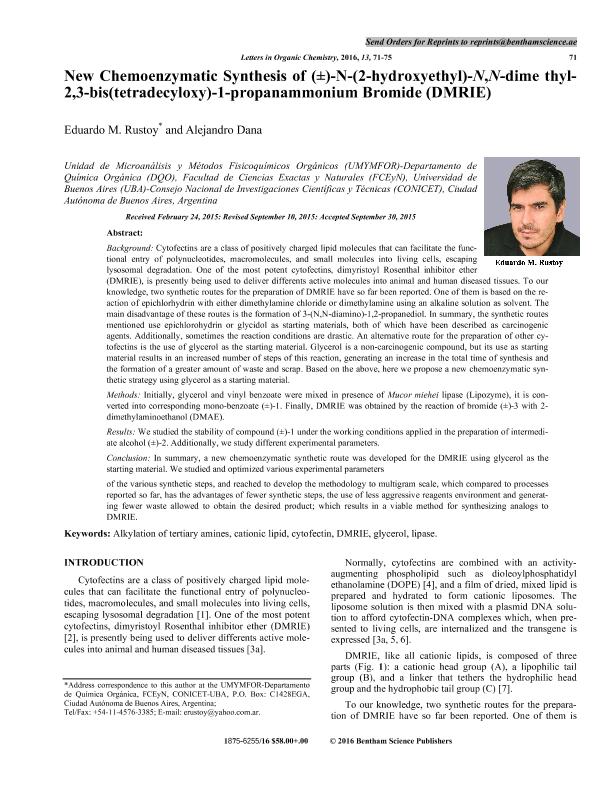Artículo
New Chemoenzymatic Synthesis of (±)-N-(2-hydroxyethyl)-N,N-dime thyl- 2,3-bis(tetradecyloxy)-1-propanammonium Bromide (DMRIE)
Fecha de publicación:
12/2015
Editorial:
Bentham Science Publishers
Revista:
Letters In Organic Chemistry
ISSN:
1570-1786
e-ISSN:
1875-6255
Idioma:
Inglés
Tipo de recurso:
Artículo publicado
Clasificación temática:
Resumen
Background: Cytofectins are a class of positively charged lipid molecules that can facilitate the functional entry of polynucleotides, macromolecules, and small molecules into living cells, escaping lysosomal degradation. One of the most potent cytofectins, dimyristoyl Rosenthal inhibitor ether (DMRIE), is presently being used to deliver differents active molecules into animal and human diseased tissues. To our knowledge, two synthetic routes for the preparation of DMRIE have so far been reported. One of them is based on the reaction of epichlorhydrin with either dimethylamine chloride or dimethylamine using an alkaline solution as solvent. The main disadvantage of these routes is the formation of 3-(N,N-diamino)-1,2-propanediol. In summary, the synthetic routes mentioned use epichlorohydrin or glycidol as starting materials, both of which have been described as carcinogenic agents. Additionally, sometimes the reaction conditions are drastic. An alternative route for the preparation of other cytofectins is the use of glycerol as the starting material. Glycerol is a non-carcinogenic compound, but its use as starting material results in an increased number of steps of this reaction, generating an increase in the total time of synthesis and the formation of a greater amount of waste and scrap. Based on the above, here we propose a new chemoenzymatic synthetic strategy using glycerol as a starting material. Methods: Initially, glycerol and vinyl benzoate were mixed in presence of Mucor miehei lipase (Lipozyme), it is converted into corresponding mono-benzoate (±)-1. Finally, DMRIE was obtained by the reaction of bromide (±)-3 with 2- dimethylaminoethanol (DMAE). Results: We studied the stability of compound (±)-1 under the working conditions applied in the preparation of intermediate alcohol (±)-2. Additionally, we study different experimental parameters. Conclusion: In summary, a new chemoenzymatic synthetic route was developed for the DMRIE using glycerol as the starting material. We studied and optimized various experimental parameters of the various synthetic steps, and reached to develop the methodology to multigram scale, which compared to processes reported so far, has the advantages of fewer synthetic steps, the use of less aggressive reagents environment and generating fewer waste allowed to obtain the desired product; which results in a viable method for synthesizing analogs to DMRIE.
Palabras clave:
Alkylation of Tertiary Amines
,
Cytofectin
,
Dmrie
,
Lipase
Archivos asociados
Licencia
Identificadores
Colecciones
Articulos(UMYMFOR)
Articulos de UNID.MICROANAL.Y MET.FISICOS EN QUIM.ORG.(I)
Articulos de UNID.MICROANAL.Y MET.FISICOS EN QUIM.ORG.(I)
Citación
Rustoy, Eduardo Miguel; Dana, Alejandro Leonel; New Chemoenzymatic Synthesis of (±)-N-(2-hydroxyethyl)-N,N-dime thyl- 2,3-bis(tetradecyloxy)-1-propanammonium Bromide (DMRIE); Bentham Science Publishers; Letters In Organic Chemistry; 13; 1; 12-2015; 71-75
Compartir
Altmétricas




